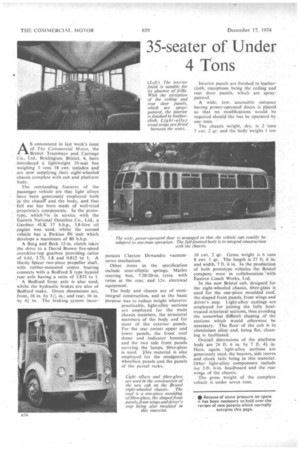35-seater of Under 4 Tons
Page 72

If you've noticed an error in this article please click here to report it so we can fix it.
AS announced in last week's issue of The Commercial Motor, the Bristol Tramways and Carriage Co., Ltd., Brislington, Bristol, 4, have ,introduced a lightweight 35-seat bus weighing 3 tons 18 cwt. unladen and are now supplying their eight-wheeled chassis complete with cab and platform body.
The outstanding features of the passenger vehicle art that light alloys have been generously employed both in the chassir and the body, and thatfull use has been made of well-tried proprietary components. In the prototype, which is in service with the Eastern National Omnibus Co., Ltd., a Gardner 4LK 57 b.h.p., 3.8-litre oil engine was used, whilst the second vehicle has a Perkins P6 unit which develops a maximum of 80 b.h.p.
A Borg and Beck 12-in, clutch takes the drive to a David Brown five-speed overdrive-top gearbox providing ratios of 6.61, 3.75, 1.8 and 0.812 to I. A Hardy Spicer two-piece propeller shaft, with rubber-mounted centre bearing connects with a Bedford S type hypoid rear axle having a ratio of 5.833 to 1. ' A Bedford front axle is also used, whilst the hydraulic brakes are also of Bedford make. Drum dimensions are, front. 16 in. by n; in.; and rear, 16 in. by 41 in. The braking system incor
porates Clayton Dewandre vacuumservo mechanism.
Other items in the specification include semi-elliptic springs, Marles steering box, 7.50-20-in. tyres, with twins at the rear; and 12v. electrical equipment.
The body and chassis are of semiintegral construction, and as the basic purpose was to reduce weight wherever practicable, light-alloy sections arc employed for the main chassis members, the structural members of the body and for most of the exterior panels. For the rear corner upper and lower panels, the front roof dome and indicator housing, and the two side front panels carrying the lamps, fibre-glass is used. This material is also employed for thel mudguards; wheelbox panels and the panels of the parcel racks. Interior panels are finished in leathercloth, exceptions being the ceiling and rear door panels, which are spraypainted.
A wide, low, accessible entrance having power-operated doors is placed so that no modifications would be required should the bus be operated by one man. '
The chassis weight, dry, is 2 tons 7 cwt. 2 qr. and the body weighs I ton
10 cwt. 2 qr. Gross weight is 6 tons 8 cwt. 1 qr. The length is 27 ft, 6 in. and width, 7 ft. 6 in. In the production of both prototype vehicles the Bristol company were in collaboration with Eastern Coach Works, Ltd.
In the new Bristol cab, designed for the eight-wheeled chassis, fibre-glass is used for the one-piece moulded roof, the shaped front panels, front wings and driver's step. Light-alloy castings are employed for joining the fully heattreated structural sections, thus avoiding the somewhat difficult shaping of the sections which would otherwise be necessary. The floor of the cab is in aluminium alloy and, being flat, cleaning is facilitated.
Overall dimensions of the platform body are 24 ft. 6 in. by 7 ft. 4-01 in. Here, again, light-alloy sections are generously used, the bearers, side reeves and chock rails being in this material. Other light-alloy components include the 2-ft. 6-in, headboard and the rear wings of the chassis.
The gross weight of the complete vehicle is under seven tons.
Light alloys and fibre-glass are used in the construction of the new cab on the • Bristol eight-wheeled chassis. The roof is a one-piece moulding ' offihre-glass, the shaped front panels, front wings and driver's step being also moulded in












































































































